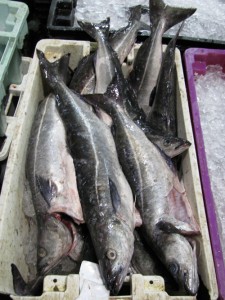
The Atlantic pollock ( Pollachius virens) is related to the cod and haddock. Pollock are olive green above, paling on the lower sides to yellow-gray, and silver gray on the belly.
This species differs in appearance from others in the cod family by having a pointed snout and a projecting lower jaw, a more rounded body, and a forked rather than a square tail.
Pollock is a medium to large-sized fish that averages 4-15 pounds and 2-3 feet long. This species can grow to 40 pounds.
Atlantic pollock are sold commercially as Boston bluefish, merlan, colin, saithe, and coalfish (particularly in the United Kingdom).
Pollock occur on both sides of the North Atlantic. In the Northwest Atlantic, the species is most abundant on the western Scotian Shelf and in the Gulf of Maine.
Atlantic pollock is a lean fish with somewhat darker flesh than cod. It is sold fresh (whole, steaks, fillets); and frozen (whole, steaks, fillets, IQF and blocks). Pollock is frequently salted and cured for export.
Pollock’s light flaky flesh can be substituted for cod, haddock similar whitefish in recipes. Pollock can be poached, baked, broiled, grilled, or put into fish chowders. Atlantic pollock makes good fish and chips. Because it has about a third more fat than cod, it’s more versatile and flavorful.
Related Information